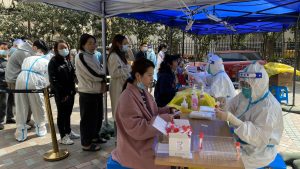While the world was already phasing out COVID-19 prevention measures, major Chinese cities were again placed under strict lockdowns in 2022. In the spring, shocking videos from Shanghai appeared in social and mainstream media, showing residents screaming from their balconies amid another strict lockdown to prevent the spread of COVID-19.
What followed in the second half of 2022 was even more shocking. There were news reports of residents committing suicide when they could not receive any health services other than COVID-19 treatment, and an entire family perished in a fire when fire fighters were not allowed into their locked-down compound.
Factory workers first took the streets to protest the strict lockdown measures, and were then followed by university students in big cities in late 2022. In response to the protests, the central government ordered the gradual easing of local measures, then changed centrally planned policies such as quarantine rules for international arrivals.
Now, facing mounting case counts, local governments are once again on their own to decide how to cope with the post-zero COVID surge. Looking at how they coped with the pandemic in its initial stages helps us understand their responses today.
China startled the world with a full lockdown of the city of Wuhan for two months in the early stages of the pandemic in 2020. Since then, the general assumption is that Chinese pandemic management was uniform across the country and was decided by the central government in a top-down manner.
As a political scientist specializing in China’s local governance, I looked at local practices to see if this was the case. I have compiled a database of local government policy documents during the initial stage of the pandemic. Based on my research, there was much variation in the way China’s provinces and major cities implemented pandemic policies. The socioeconomic development level of localities seems to determine the different pandemic policies of the various provinces and cities.
All provincial capitals declared a Stage 1 emergency before the provincial governments did, in order to accelerate emergency governance measures. However, the length and form of these lockdowns varied greatly. Lockdowns included pausing production to reduce mobility within cities and reducing mobility across cities through the use of digital health tracking applications. Each province developed its own digital COVID-tracking app and shied away from sharing data with other provinces to avoid being stigmatized for their numbers.
Cities that have high investment rates, such as those located on China’s well-off east coast, cut the lockdowns short, resumed production, and channeled the government’s pandemic subsidies to firms to prevent bankruptcies. Two of the most developed places in China, Shanghai city and Zhejiang province lifted lockdowns as early as February 9, 2020. This makes the policy change that kept Shanghai under strict lockdown in early 2022 even more striking.
In contrast, cities with large working-class populations, such as those in central and western China, limited mobility with extended lockdowns in 2020, and funneled subsidies into poverty and unemployment funds.
My database includes 900 public health-related policy documents and 739 welfare-related policy documents issued in the period from the imposition of the first city-level lockdown to the lifting of the last one in the first half of 2020. Among the welfare-related policies, 523 of them were meant to keep local businesses afloat, and 220 of them were to provide social relief to those who lost their jobs and support systems, such as childcare and elderly care, during the lockdown.
Among the policy documents relating to businesses, 80 of them were dedicated solely to tax pardons and loan repayments for small- and medium-sized enterprises. Local governments saw saving local businesses as a solution to the unemployment problem as well. Therefore, there are only 15 documents in my database related to employment and labor relations.
Among 130 industrial policies, 40 of them were to alleviate the pressure on the real estate and construction industries and another 40 were for heavy and high-tech industries. This breakdown suggests continuity in the policy priorities between the central and local governments over the years, because the Joint Economic Work Conference convened in December 2022 had similar suggestions. The Work Conference final report is considered an important precedent of the official policies to be announced in March 2023.
All policies in the database show signs of prioritizing local governments’ own needs, known as local protectionism. The variation among economic policies also demonstrates the unevenness of regional development in China. Local protectionism shapes China’s other national policies as well. Among those, variation in local industrial policies in the post-zero COVID era is highly relevant to issues including China’s changing role in global supply chains and energy mix.
This piece is based on a longer journal article, “Local variation and central-local relations in China’s pandemic management,” published in the Journal of Asian Public Policy.

































